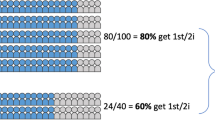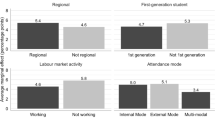Abstract
Recognizing the current administration’s focus on improving postsecondary access, this study examines resource allocation patterns and the predictive power of these resources in increasing the likelihood of 2- and 4-year college enrollment among low-income students. Using data from the Educational Longitudinal Study, college choice decision-making is conceptualized in relation to an individual’s habitus and capital deficiency theory. The results reveal significant differences in the availability and predictive power of various forms of capital across enrollment classifications. The study concludes with implications for administrators and policymakers interested in improving access for low-income students.
Similar content being viewed by others
References
ACT. (2010). Mind the gaps: How college readiness narrows achievement gaps in college success. http://www.act.org/research/policymakers/pdf/MindTheGaps.pdf. Accessed 14 Nov 2010.
Adelman, C. (1999). Answers in the tool box: Academic intensity, attendance patterns, and bachelor’s degree attainment. Washington, DC: Office of Educational Research and Improvement, U.S. Department of Education.
Baum, S., Ma, J., & Payea, K. (2010). Education pays 2010: The benefits of higher education for individuals and society. Washington, DC: The College Board.
Becker, G. S. (1993). Human capital: A theoretical and empirical analysis with special reference to education (3rd ed.). Chicago, IL: University of Chicago Press.
Bell, A. D., Rowan-Kenyon, H. T., & Perna, L. W. (2009). College knowledge of 9th and 11th grade students: Variation by school and state context. The Journal of Higher Education, 80, 663–685.
Berkner, L., & Chavez, L. (1997). Access to postsecondary education for the 1992 high school graduates, NCES 98–105. Washington, DC: United States Department of Education.
Bourdieu, P. (1986). The forms of capital. In J. G. Richardson (Ed.), Handbook of theory and research for the sociology of education (pp. 241–258). New York: Greenwood Press.
Bozick, R., & Lauff, E. (2007). Education longitudinal study of 2002 (ELS:2002): A first look at the initial postsecondary experiences of the sophomore class of 2002 (NCES 2008–308). Washington, DC: National Center for Education Statistics, Institute of Education Sciences, U.S. Department of Education.
Cabrera, A. F., & La Nasa, S. M. (2001). On the path to college: Three critical tasks facing America’s disadvantaged. Research in Higher Education, 42, 119–149.
Carnevale, A. (2010, Oct). The shortfall: Not enough Americans are completing college. CASE Currents, 15–16.
Cohn, E., & Geske, T. G. (1990). The economics of education (3rd ed.). New York, NY: Pergamon Press.
Coleman, J. S. (1988). Social capital in the creation of human capital. American Journal of Sociology, 94, S95–S120.
Coleman, J. S., Campbell, E. Q., Hobson, C. J., McPartland, J., Mood, A., Weinfeld, F. D., et al. (1966). Equality of educational opportunity. Washington, DC: U.S. Department of Health, Education & Welfare, Office of Education (OE-38001).
Duncan, A. (2010, Feb 1). Class warrior. The New Yorker, 24–29.
Eckholm, E. (2010, Sep 16). Recession raises poverty rate to a 15-year high. The New York Times. http://www.nytimes.com/2010/09/17/us/17poverty.html?_r=1&scp=1&sq=eckholm+recession+raises+poverty&st=nyt. Accessed 17 Sep 2010.
Ellwood, D. T., & Kane, T. J. (2000). Who is getting a college education? Family background and the growing gaps in enrollment. In S. Danziger & J. Waldfogel (Eds.), Securing the future: Investing in children from birth to college (pp. 283–324). New York, NY: Russell Sage Foundation.
Engberg, M. E., & Wolniak, G. C. (2010a). Examining the effects of high school contexts on postsecondary enrollment. Research in Higher Education, 51(3), 132–153.
Engberg, M. E., & Wolniak, G. C. (2010b, May). An examination of the moderating effects of the high school socioeconomic context on college enrollment. Paper presented at the Annual Meeting of the American Educational Research Association, Denver, CO.
Fitzgerald, B. K., & Delaney, J. A. (2002). Educational opportunity in America. In D. E. Heller (Ed.), Condition of access: Higher education for lower income students (pp. 3–24). Westport, CT: Praeger.
Hamrick, F. A., & Stage, F. K. (2004). College predisposition at high-minority enrollment, low-income schools. Review of Higher Education, 27, 151–168.
Hill, L. D. (2008). School strategies and the “College-Linking” process: Reconsidering the effects of high schools on college enrollment. Sociology of Education, 81, 53–76.
Hossler, D., Braxton, J., & Coopersmith, G. (1989). Understanding student college choice. In J. C. Smart (Ed.), Higher education: Handbook of theory and research (Vol. V, pp. 231–288). New York: Agathon Press.
Hossler, D., Schmit, J., & Vesper, N. (1999). Going to college: How social, economic, and educational factors influence the decisions students make. Baltimore: Johns Hopkins University Press.
Ingels, S. J., Pratt, D. J., Rogers, J. E., Siegel, P. H., & Stutts, E. S. (2004). Education longitudinal study of 2002: Base year data file user’s manual. Washington, DC: U.S. Department of Education, National Center for Education Statistics.
Kane, T. J. (1995). Rising public college tuition and college entry: How well do public subsidies promote access to college? Working Paper no. 5164. Cambridge, MA: NBER, April 1995.
Kane, T. J. (1999). The price of admission: Rethinking how Americans pay for college. Washington, DC: Brookings Institute Press.
Li, K. H., Raghunathan, T. E., & Rubin, D. B. (1991). Large-sample significance levels from multiply imputed data using moment-based statistics and an F reference distribution. Journal of the American Statistical Association, 86, 1065–1073.
Lin, N. (2001). Social capital: A theory of social structure and action. New York: Cambridge University Press.
Luna de la Rosa, M. (2006). Is opportunity knocking?: Low-income students’ perceptions of college and financial aid. American Behavioral Scientist, 49, 1670–1686.
Massey, D. S., Charles, C. Z., Lundy, G. F., & Fischer, M. J. (2003). The source of the river: The social origins of freshmen at America’s selective colleges and universities. Princeton, NJ: Princeton University Press.
McDonough, P. M. (1997). Choosing colleges: How social class and schools structure opportunity. Albany, NY: State University of New York Press.
McPherson, M., & Schapiro, M. O. (1991). Does student aid affect college enrollment? New evidence on a persistent controversy. American Economic Review, 81, 309–318.
McPherson, M., & Schapiro, M. O. (1997). Financing undergraduate education: Designing national policies. National Tax Journal, 50, 557–571.
Obama, B. (2009). Remarks of president Barack Obama—Address to joint session of Congress. http://www.whitehouse.gov/the_press_office/Remarks-of-President-Barack-Obama-Address-to-Joint-Session-of-Congress/. Accessed 30 May 2010.
Obama, B. (2010). Remarks of president Barack Obama—Address to joint session of Congress. http://www.whitehouse.gov/the-press-office/remarks-president-state-union-address. Accessed 30 May 2010.
O’Connor, N., Hammack, F. M., & Scott, M. A. (2010). Social capital, financial knowledge, and Hispanic student college choices. Research in Higher Education, 51, 195–219.
Paulsen, M. B. (2001). The economics of human capital and investment in higher education. In M. B. Paulsen & J. C. Smart (Eds.), The finance of higher education: Theory, research, policy, and practice (pp. 55–94). New York: Agathon Press.
Perez, L., & McDonough, P. (2008). Understanding Latina and Latino college choice: A social capital and chain migration analysis. Journal of Hispanic Higher Education, 7, 249–265.
Perna, L. W. (2000). Differences in the decision to enroll in college among African Americans, Hispanics, and Whites. Journal of Higher Education, 71, 117–141.
Perna, L. W. (2004). The key to college access: A college preparatory curriculum. In W. G. Tierney, Z. B. Corwin, & J. E. Colyar (Eds.), Preparing for college: Nine elements of effective outreach (pp. 113–134). Albany, NY: State University of New York Press.
Perna, L. W. (2006). Studying college access and choice: A proposed conceptual model. In J. C. Smart (Ed.), Higher education: Handbook of theory and research (Vol. XXI, pp. 99–157). The Netherlands: Springer.
Perna, L. W., & Titus, M. A. (2005). The relationship between parental involvement as social capital and college enrollment: An examination of racial/ethnic group differences. Journal of Higher Education, 76, 486–518.
Person, A. E., & Rosenbaum, J. E. (2006). Chain enrollment and college enclaves: Benefits and drawbacks of Latino college students’ enrollment decisions. In C. L. Horn, S. Flores, & G. Orfield (Eds.), New directions for community colleges (pp. 51–60). San Francisco: Jossey-Bass.
Putnam, R. (1995, Dec). Tuning in, tuning out: The strange disappearance of social capital in America. Political Science and Politics, 664–683.
Sallie Mae. (2010). How America pays for college: Sallie Mae’s national study of college students and parents conducted by Gallop. https://www.salliemae.com/NR/rdonlyres/D5D78A1C-BBB8-4D97-AE9B-7EC35558AD5F/13389/SLMGallupReportHowAmericaPaysforCollege81010FINAL1.pdf. Accessed 1 Nov 2010.
Schafer, J. L. (1997). Analysis of incomplete multivariate data. London: Chapman and Hall.
Shackman, G. (2001, March). Sample size and design effect . Presentation at Albany Chapter of American Statistical Association. http://faculty.smu.edu/slstokes/stat6380/deff%20doc.pdf. Accessed 20 May 2010.
St. John, E. P. (1991). What really influences minority attendance? Sequential analysis of the high school and beyond sophomore cohort. Research in Higher Education, 32, 141–158.
St. John, E. P. (2003). Refinancing the college dream: Access, equal opportunity, and justice for taxpayers. Baltimore, MD: Johns Hopkins University Press.
Terenzini, P. T., Cabrera, A. F., & Bernal, E. M. (2001). Swimming against the tide: The poor in American higher education. Report No. 2001–1. New York, NY: College Entrance Examination Board.
U.S. Department of Education. (2010a). ESEA blueprint for reform. Washington, D.C.: Office of Planning, Evaluation and Policy Development: http://www2.ed.gov/policy/elsec/leg/blueprint/blueprint.pdf. Accessed 21 May 2010.
U.S. Department of Education. (2010b). Federal TRIO programs current-year low-income levels. http://www2.ed.gov/about/offices/list/ope/trio/incomelevels.html. Accessed 1 Nov 2010.
Winston, G. C. (1999). Subsidies, hierarchies, and peers: The awkward economics of higher education. Journal of Economic Perspectives, 13, 13–36.
Wolniak, G. C., & Engberg, M. E. (2007). The effects of high school feeder networks on college enrollment. Review of Higher Education, 31(1), 27–53.
Wyner, J. S., Bridgeland, J. M., & DiIulio, J. J. (2007). Achievement trap: How America is failing millions of high-achieving students from lower-income families. Landsdowne, VA: Jack Kent Cooke Foundation.
Yosso, T. (2005). Whose culture has capital? A critical race theory discussion of community cultural wealth. Race, Ethnicity and Education, 8, 69–91.
Author information
Authors and Affiliations
Corresponding author
Rights and permissions
About this article
Cite this article
Engberg, M.E., Allen, D.J. Uncontrolled Destinies: Improving Opportunity for Low-Income Students in American Higher Education. Res High Educ 52, 786–807 (2011). https://doi.org/10.1007/s11162-011-9222-7
Received:
Published:
Issue Date:
DOI: https://doi.org/10.1007/s11162-011-9222-7




